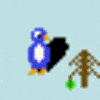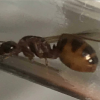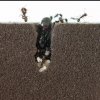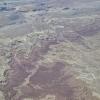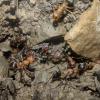Scientific Name: Prenolepis imparis
Common Name: Winter ant, in reference to its foraging at temperatures barely above freezing during the cooler months. False Honey Ant is an unfortunate name, since the storage product in the corpulent young workers of these ants is fatty, not sugary.
Distribution: Most of the United States, plus southern Ontario and Mexico.
Queen size: 8 mm
Male size: 3-4 mm
Worker size: 2.5-3.5 mm
Natural Habitat: Nest entrances are commonly found in shaded areas near the bases of trees and are characterized by having a series of short dead-end tunnels nearby, presumably for foragers to take temporary shelter from predators or the elements during cold weather. Nests in Florida have been recorded extending as far down as 3.6 meters. From the entrance, the main shaft of the nest extends vertically downward, with no chambers found shallower than 60.0 cm, after which point chambers are very common and are all directly connected to the main shaft.
Circadian Activity: Diurnal
Mating Flight: Late winter/early spring. The winged sexes that participate in the nuptial flights, mature during the late summer of the previous year and are retained in the nests over winter. This retention of the sexual phases over winter occurs in a few of our other northern ants. The very early flight of P. impairs first observed in the beginning of spring; February for Florida, followed as states warm to 70 degrees. The queens fly in the afternoon.
Queen Founding Method: Fully claustral
Monogyne or Polygyne: Both. They can be either Monogyne or Polygyne.
Average time from egg to worker: Slow species usually take about 2 months from egg to adult. Sometimes even 3[/size][/color]
Recommended Temperature: 65-75 F.
Recommended Humidity: Prefers deep chambers closer to moist clays and soils.
Preferred Foods: Workers feed on honeydew, secretions of floral, sap flows, exudates from galls, earthworms and arthropods (usually as carrion), and ripened or decaying fruit.
Hibernation Details: P. imparis do no not hibernate, but have a distinct estivation period. As an apparent adaptation for this estivation, most workers (average 78%) were in the "replete" state. During estivation, eggs are laid and reared, and new workers emerge in "winter". In north Florida, the ant is absent above-ground for 7 to 8 months, foraging only during the winter.
Escape Barrier Methods: Talcum powder or Fluon
Difficulty rating: Starting an ant colony with P. imparis is fairly simple. You need a good starting habitat and it's recommend to place at least two queens together to increase the chances of them founding a strong colony. Mortality rate for newly mated queens is high (estimated in the wild as high as 95%/100%), You can feed the queens a little sweet liquid at first, but then they will not need feeding until after the first workers arrive in a couple months. It is important to know that subsequent generations of workers will not take as long as the first to go from egg to worker. P. imparis queens are easily disturbed like most queens. When disturbed during the founding stage, they will quickly abandon their eggs. This means that keeping them shielded from vibrations, light, and airflow is very important. If you are used to keeping some queens where you can leave them out in the open without worry, these queens are not as suited for that type of environment.
Bite and/or Sting rating: No sting or bite.
Special Care or Interesting Notes: The two sexes were quite different in color hence he named the species imparis.
Additional Links:
http://entnemdept.uf...pis_imparis.htm
http://bugguide.net/node/view/27323
http://www.bio.fsu.e...ions/1987-3.pdf
https://www.jstor.or...an_tab_contents
http://antfarm.yuku....in#.WK3AXm_ythE
http://www.formicult...bers/#entry7398
http://www.orkin.com...all-honey-ants/
http://tarheelants.b...antnuptial.html
http://antfarm.yuku....ny#.WK3Exm8rJhE
Information submitted by Jamie_Garrison
Edited by dspdrew, March 5 2022 - 7:55 PM.








